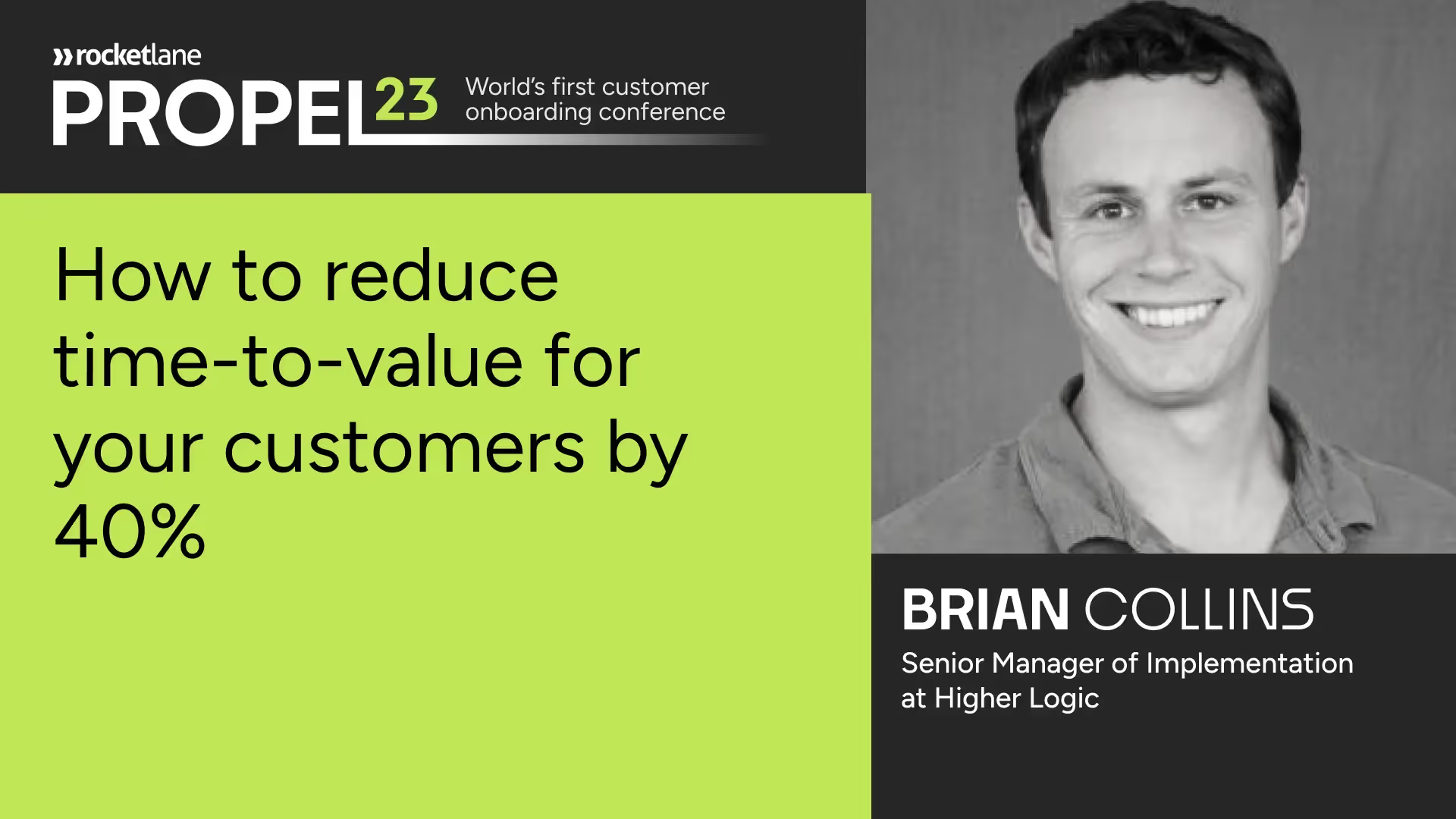More resources:
- Tune into a Preflight conversation about best practices for measuring time to value.
- Wondering how to reduce your customer’s TTV? Read all about it on our blog.
- Learn how to reduce churn by leveraging customer onboarding.
- Discover when the right time is to invest in customer onboarding software.
When asked, "How does a project get to be a year behind schedule?" Fred Brooks, renowned computer architect, is said to have famously responded, "One day at a time." Every day that obstructs the implementation process greatly impacts the overall time-to-value for the customer.
At Propel23, Brian Collins, Senior Manager - Implementation and Services at Higher Logic, discussed time-to-value and five telltale signs of customer dissatisfaction. He delved deeper into tips on improving TTV for your customers to grow your business.
In this session, Brian spoke about:
- Why time-to-value matters to an organization
- How the customers express their dissatisfaction
- Five ideas to improve the customer onboarding experience
Here are the key takeaways from the session.
What is time-to-value?
Time to Value (TTV) refers to the duration customers need to experience the benefits of your product or solution. Once a prospect becomes your customer, their acknowledgment of value becomes the priority.
The perception of value can vary depending on the product or service you provide and differs for each company. For instance, a subscription-based company aims to deliver value from the moment the contract is signed. Failing to do so may result in the non-renewal of the contract.
The hype cycle of onboarding: The customer’s perspective of a one-year renewal

Here’s a quick look at the customer’s perspective of a one-year contract renewal and the thought process behind it.
Phase 1: Need(s) identification: Sales meets a prospect and starts selling the value up until the deal is sold.
Phase 2: Deal finalization: Also known as the Peak of Expectations, in this phase, you either meet, exceed, or do not meet expectations. If you lack involvement in your pre-sales motion or have not enabled your sales team to position your services best and set expectations, the curve will dip here.
Phase 3: Deployment: This is the phase commonly known as the trough of disillusionment. Customers suffer from buyer’s remorse and feel disconnected from the product. Once the work starts, there is almost always some churn at this stage.
Phase 4: Implementation: The project usually gets back on track in this phase, but the customers’ renewal risk is right out of the gate.
Phase 5: Value realization: Ultimately, in this phase, the customers see the value of your product and will mostly opt for renewal at the end of the one-year renewal. You will not see a renewal if the value isn’t seen here.
Listening to signs of customer dissatisfaction
Regardless of whether you track metrics and achieve your goals, listening to your customers is the best way to understand the greatest dissatisfaction for your customers. Here are the four signs that hint at your customers’ dissatisfaction.
Four signs of customer dissatisfaction
Sign 1: “It took forever to start our project.”
Contributing factors:
- Post-sale disappointment: Most of a project kickoff call was spent discussing what was purchased and how they intend to use it instead of discussing how to start the implementation process.
- Unclear contracts: Customers are often left in the dark about many factors, such as the modules purchased and the migration process, due to the lack of a clearly crafted contract.
- Lacking customer preparation; missing an executive sponsor. The customer is not prepared for the next steps or might be missing an executive sponsor.
Sign 2: “We didn’t expect to need developers.”
Contributing factors:
- Unclear resource requirements. Your integrations may not be as easy to implement as you initially thought. This presents a significant difficulty in project management.
- Lack of customer organizational awareness. When you fail to have an executive sponsor at the customer end, you could have customer departments caught off guard, and left scrambling for limited resources.
- Scope creep. Inefficient project management and lack of clear ownership result in delays and scope creep in customer projects. It is challenging to prioritize projects effectively and ensure successful implementation.
The project needs to be a priority for your customer. A solution here is to describe the roles necessary for successful implementation and assign ownership at the start of the project. Be sure to clarify the scope and hold your customer accountable.
Sign 3: “Your product isn’t as nice as what was demoed.”
Contributing factors:
- No standard demo practices. The absence of standardized demonstration procedures leads to unnecessary complexity for both your team and customers during project initiation. This lack of uniformity often results in widespread confusion and potential setbacks at both ends.
- “Model home” effect. The challenge lies in the lack of a practical demo environment or standardized templates for project commencement. This issue often leads to significant challenges and complications during project initiation, impacting both our team and customers.
Sign 4: “The training and documentation was confusing.”
Contributing factors:
- Documentation overload. Companies tend to offer a high volume of educational materials, often exceeding an hour's worth of content. A good question to ask yourself while creating such content is: Are our educational resources presented in a format that encourages customer engagement and consumption?
- Unclear starting point. Customers often find themselves overwhelmed by an excessive amount of information. Instead of lengthy and complex instructions, they really need simple, concise, and essential guidance. When faced with a vast repository of information, customers become confused about where to begin, which often results in them not taking any action.
- No LMS or in-platform education. The absence of a suitable educational platform or resources can result in a disconnect with the customer and the failure to meet the market’s changing requirements.
Five ideas to improve TTV
Once we understand the customer’s concerns, we must focus on how to fix them. The change starts with prioritizing customer experience. However, it has to be owned, not just by the CSMs and customer onboarding team, but by everyone. Here are 5 ideas to improve TTV and gain organizational buy-in.
Start tracking
To enhance TTV , begin by monitoring the time frames between your project milestones. Use a project management tool to track the intervals between each milestone. It doesn't have to be flawless. Just a starting point is often good enough.
First, identify your milestones and allocate a timeframe for each. As you begin working on the projects, you will gain a clearer understanding of the duration of each project phase. By recording the timelines, you can pinpoint areas for improvement and subsequently reduce your project timelines.
When calculating TTV, start from the contract sign date. If you offer a free version, measure how long customers can upgrade to the paid version to determine when they perceive value. This may differ for each customer but can still be standardized and measured over time.
It's also crucial to track customer onboarding time, adoption of new features, and time required to achieve desired ROI. Set goals, measure progress, and report regularly. Accountability is key, especially when wrapping up complex projects that can take several months.
Lastly, do not rush into making changes. Instead, be intentional and make small changes over time, as they can have a significant impact.
Clean up your house
Shift your focus towards the things that you have control over. Start with your own responsibilities, your ‘house’, and ensure that it is in good condition before concerning yourself with the efforts of others.
Once you clearly understand your desired outcome and your current position, start considering realistic and achievable objectives. It's crucial to examine every problem and take responsibility for it.
Organize and track issues, assign accountability, and present a mitigation strategy during business reviews. Utilize root cause analysis and develop specific plans for improvement.
If there are aspects you don’t have control over, approach the team responsible for them constructively and explain how their involvement impacts the overall issue. This way, you can significantly reduce the time between each project.
Reduce complexity
Customer indecision is responsible for 70% of project delays. A good question to ask yourself is: “Are you making it too difficult for customers to achieve even the minimum level of success?” Your focus should be on what is required for each customer to start experiencing the actual value of our product rather than getting caught up in every possible configuration and feature. There is a tipping point where too much information becomes overwhelming and slows down or even halts progress.
To address this, develop a pre-sale solution catering to both standard and enterprise services. Try to make configurations easier for your customers and help them understand what they can opt for – rather than overwhelming them with countless choices.
It's important to remember the minimum threshold for value and make the process easy. This includes structuring projects, creating helpful guides, and providing useful video examples. Also, consider how to standardize your processes while meeting your customers’ needs. Finding the right balance is a challenging task that only you/your team can tackle by experimenting with different approaches.
Do what (usually) works
It’s important to remember to put the customer and their needs at the center of everything you do. Not every customer will do things exactly as you want, but you can improve your processes by listening and learning from them. Progress is faster when the customers are involved and allowed to learn at their own pace rather than imposing your own ideas on them.
Ensure what you present to customers early on matches your roadmap during onboarding. This helps streamline the process and leads to faster time-to-value leads to lower churn, directly impacting company revenue and profitability.
Share your success
Making improvements is crucial, but it's equally important to communicate the overall impact of these changes. Regularly report your metrics to your team and consistently meet your monthly and quarterly targets. Demonstrating how your changes affect the bottom line will help you acquire the necessary resources for further improvement.
Lastly, reducing time-to-value is not just the responsibility of the onboarding team. It requires company-wide effort, strong leadership, and accountability from other teams.















